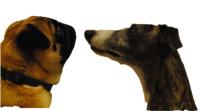Abstract

Earlier studies have suggested that there are differences in visual ability between dog breeds of extreme skull shape. The skull shape of dogs have found to correlate with ganglion cell topography. Dolichocephalic breeds have a horizontal visual streak, while brachycephalic breeds have ganglion cells concentrated in an area centralis. But it has not been investigated whether the differences in ganglion cell distribution correlate with the perceived visual acuity. The aim of this study was to determine visual acuity in breeds with extreme skull shapes, in both daylight (43 cd/m2) and dim light (0,0087 cd/m2) conditions. Whippets (N=4) and pugs (N=3) were tested in a two-choice discrimination test to achieve visual acuity thresholds. The stimuli were black and white sine-wave gratings of either horizontal or vertical orientation. In daylight, the best performing whippet reached a significant visual acuity threshold up to 16 cpd while the best pug discriminated stimuli of 24 cpd. This acuity threshold is better than what has previously been documented in dogs. In dim light conditions, all but one dog discerned two cpd. In daylight conditions there was an interesting trend, not significant, (r=0,089, P=0,87) between skull shape and visual acuity. To set conclusive results this trend needs to be investigated further with more test individuals. Hence, this study indicates that breeding dogs for appearance has not only resulted in extreme skull shapes but also affected the visual ability of the dogs.
Responsible for this page:
Director of undergraduate studies Biology
Last updated:
05/03/16
